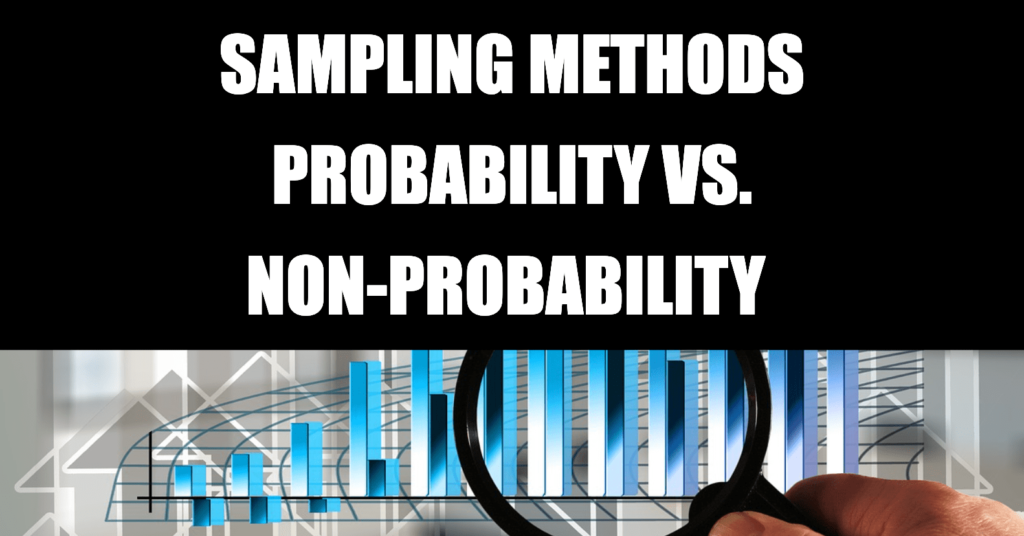PROJECT MART - College Project Service
For help with an academic project, text right now.
Sampling methods play a crucial role in gathering information from a subset of a larger population. These methods are essential for drawing meaningful conclusions and making informed decisions based on collected data. Among the various sampling techniques, probability and non-probability sampling stand out as fundamental approaches, each with its unique characteristics and applications.
What is Probability and Non-Probability Sampling?
Probability sampling involves selecting a sample from a population using a method based on chance. In this approach, every member of the population has a known and non-zero probability of being included in the sample. On the other hand, non-probability sampling does not rely on random selection; instead, individuals are chosen based on the researcher’s judgment or convenience.
Probability Sampling and Non-Probability Sampling Types
Probability sampling encompasses several methods, including simple random sampling, where each member of the population has an equal chance of being selected, and stratified sampling, which involves dividing the population into homogeneous groups and then randomly selecting samples from each group. Other techniques such as systematic sampling, cluster sampling, and multi-stage sampling are also common in probability sampling.
Non-probability sampling methods include convenience sampling, where individuals who are readily available or accessible are chosen for the sample, and purposive sampling, where researchers intentionally select participants based on specific criteria. Snowball sampling, quota sampling, and judgmental sampling are among the other non-probability sampling techniques frequently used in research.
Probability Sampling and Non-Probability Sampling Examples
To illustrate probability sampling, imagine a study aiming to understand the preferences of a population regarding a particular product. Using simple random sampling, researchers randomly select individuals from a list of all potential consumers, ensuring that each person has an equal chance of being included in the study. In contrast, non-probability sampling might involve surveying shoppers at a specific store, which may not represent the broader population accurately.
Difference Between Probability Sampling and Non-Probability Sampling
One key distinction between probability and non-probability sampling lies in the randomness of selection. Probability sampling methods aim to minimize bias by ensuring that each member of the population has an equal opportunity to be included in the sample. In contrast, non-probability sampling methods may introduce bias since individuals are not randomly selected, potentially leading to results that are not representative of the entire population.
Types of Probability and Non-Probability Sampling
Probability sampling encompasses various techniques tailored to different research scenarios, such as stratified sampling for heterogeneous populations and cluster sampling for geographically dispersed populations. Non-probability sampling methods offer flexibility and practicality, with options like convenience sampling suitable for exploratory studies and snowball sampling useful for researching hard-to-reach populations.
Advantages and Disadvantages of Probability Sampling
One of the primary advantages of probability sampling is its ability to provide representative samples that allow for generalizability to the entire population. Additionally, probability sampling facilitates statistical analysis, enabling researchers to make valid inferences and draw conclusions based on probability theory. However, probability sampling can be resource-intensive and time-consuming, especially when dealing with large or diverse populations.
Advantages and Disadvantages of Non-Probability Sampling
Non-probability sampling methods offer simplicity and cost-effectiveness, making them suitable for studies with limited resources or time constraints. These methods also provide accessibility, allowing researchers to reach specific populations quickly. However, non-probability sampling may yield results that are less reliable due to sampling bias and lack of representativeness, limiting the generalisability of findings.
Advantages of Probability Sampling:
Representativeness: Probability sampling ensures that each member of the population has an equal chance of being selected, resulting in a sample that accurately represents the population characteristics.
Statistical Inference: Since probability sampling methods are based on random selection, statistical techniques can be applied to analyze the data and make valid inferences about the population parameters.
Generalizability: Findings derived from probability samples are more likely to be generalized to the entire population, enhancing the external validity of the research.
Reduced Bias: Probability sampling minimizes selection bias, as it provides an unbiased method for selecting samples from the population, leading to more reliable results.
Diverse Applications: Probability sampling techniques are versatile and can be applied to various research contexts, making them suitable for a wide range of studies.
Disadvantages of Probability Sampling:
Resource Intensive: Probability sampling methods can be time-consuming and require substantial resources, especially when dealing with large or dispersed populations.
Complexity: Some probability sampling techniques, such as stratified or cluster sampling, may be complex to implement and require careful planning and execution.
Potential for Sampling Error: Despite efforts to ensure random selection, probability sampling is susceptible to sampling error, which can affect the accuracy of the results.
Infeasibility for Certain Populations: Probability sampling may not be feasible or practical for certain populations, such as hard-to-reach or hidden populations, limiting its applicability in such cases.
Ethical Considerations: In some cases, random selection may raise ethical concerns, particularly when certain groups within the population are disadvantaged or marginalized.
Advantages of Non-Probability Sampling:
Simplicity: Non-probability sampling methods are often simpler and more straightforward to implement, making them suitable for studies with limited resources or time constraints.
Accessibility: Non-probability sampling allows researchers to quickly and easily access specific populations or groups of interest, facilitating data collection in diverse settings.
Cost-Effectiveness: Non-probability sampling can be more cost-effective than probability sampling, as it may require fewer resources and less time to implement.
Flexibility: Non-probability sampling methods offer flexibility, allowing researchers to adapt their sampling approach to suit the specific needs of their study or research objectives.
Practicality: Non-probability sampling is often practical for exploratory or pilot studies, where the primary focus is on generating hypotheses or insights rather than obtaining representative samples.
Disadvantages of Non-Probability Sampling:
Lack of Representativeness: Non-probability sampling methods may result in samples that are not representative of the population, leading to biased or skewed results.
Limited Generalizability: Findings derived from non-probability samples may not be generalizable to the entire population, reducing the external validity of the research.
Sampling Bias: Non-probability sampling introduces the risk of sampling bias, as certain individuals or groups may be overrepresented or underrepresented in the sample, affecting the validity of the results.
Difficulty in Statistical Analysis: Non-probability samples may pose challenges for statistical analysis, as the lack of random selection makes it difficult to apply certain statistical techniques or make valid inferences.
Subjectivity: Non-probability sampling methods rely on the researcher’s judgment or convenience, which can introduce subjectivity and undermine the reliability of the findings.
Probability Sampling Project Ideas:
National Health Survey: Use simple random sampling to select households from a national database and conduct health surveys to assess the prevalence of chronic diseases, healthcare utilization, and health behaviors among the population.
Employee Satisfaction Survey in a Company: Employ stratified random sampling to select employees from different departments within a company and administer satisfaction surveys to gather feedback on workplace culture, job satisfaction, and organizational policies.
Randomized Controlled Trial for a New Drug: Randomly assign patients with a specific medical condition to either a treatment group receiving a new drug or a control group receiving a placebo. Measure health outcomes to evaluate the effectiveness of the new treatment.
Exit Polling in Elections: Use systematic random sampling to select polling stations across different regions and conduct exit polls to gather voter preferences and demographics. Analyze the data to predict election outcomes and understand voting trends.
Quality Control Sampling in Manufacturing: Implement random sampling techniques to select products from production lines for quality control inspections. Assess product quality and identify areas for process improvement to ensure consistency and customer satisfaction.
Non-Probability Sampling Project Ideas:
Convenience Sampling for Customer Feedback: Survey customers at a retail store or restaurant using convenience sampling to gather feedback on their experience, satisfaction levels, and suggestions for improvement.
Purposive Sampling for Expert Interviews: Identify experts in a particular field through purposive sampling and conduct interviews to gather insights on emerging trends, challenges, and opportunities within the industry.
Snowball Sampling for Rare Diseases Research: Utilize snowball sampling to recruit individuals affected by rare diseases through patient support groups or online forums. Collect data on disease symptoms, treatment experiences, and quality of life to inform research and advocacy efforts.
Judgment Sampling for Product Design Evaluation: Gather feedback on a new product design by presenting prototypes to a select group of target users using judgment sampling. Solicit opinions on usability, aesthetics, and features to guide product refinement.
Quota Sampling for Market Segmentation: Implement quota sampling to ensure representation of different demographic groups in a market research study. Collect data on consumer preferences, purchasing behaviors, and brand perceptions to inform marketing strategies.
Conclusion
In summary, probability and non-probability sampling are two primary approaches used in research to select samples from populations of interest. While probability sampling ensures random selection and representative samples, non-probability sampling offers convenience and practicality. Understanding the differences, advantages, and disadvantages of each method is crucial for researchers to choose the most appropriate sampling technique based on their study objectives and constraints. By employing the right sampling method, researchers can enhance the validity and reliability of their findings, ultimately contributing to the advancement of knowledge in their respective fields.







